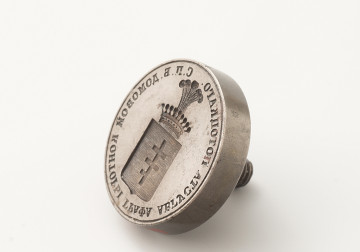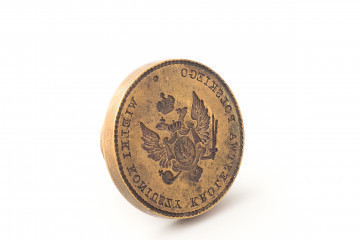
Seal matrix of the Church Administration of the Wilanów Parish
Museum of King Jan III's Palace at Wilanów
Part of the collection: Varia
In the collection of the Museum of King Jan III’s Palace at Wilanów, almost forty sphragistics pieces – seals or seal matrixes – have survived. The term ‘sphragistics’ is derived from the Greek word ‘sphragis’ standing for a seal (alternatively called sigillography after the Latin word ‘sigillum’) and defines the branch of auxiliary historical sciences where research focuses on interpreting the meaning of seals and determining the circumstances of their creation. The history of sphragistics dates back to the 19th century; at that time, it was noticed that seals could serve as a valuable source material contributing knowledge on political, heraldic and diplomacy arrangements as well as other motifs concerning the past.
The set of seals and seal matrixes preserved in the collection of the Museum dates back to the 18th century. Seals and matrixes are connected not only with the Wilanów estate. The set contains objects that can be associated with specific persons – the owners of Wilanów in the context of posts held by them, but also objects that document the system of administering estates and their functioning, not only the Wilanów estate.
The object shown here is an ink seal matrix (other matrixes can be used for lacquer seals). The part containing the sign to be impressed was made in brass, has an oval shape and is convexly engraved (i.e., the impressed image protrudes against the concave background). The matrix has a long wooden mushroom-shaped light brown handle. In the seal field, there is a Swiss escutcheon (the term defines its shape) with the Pilawa emblem – two and a half of a cross in a blue field (such is the standard colour of the background on coloured representations). Over the escutcheon, there is a nine-stick count’s crown with a plume of five ostrich feathers; under the escutcheon, two order crosses hang on ribbons. The escutcheon is surrounded with a chain of the Order of the White Eagle with the Great Cross and a circumscription indicating the owner of the mark: C. POTOCKI. STANISLAUS. He was Stanisław Kostka Potocki (1755–1821), a co-owner of the Wilanów Palace, who made the former mansion of King John III Sobieski available to everyone. Potocki was a chevalier of four orders; apart from the aforementioned Order of the White Eagle, he received also the National Order of the Legion of Honour, the Order of Saint Stanislaus and the Order of Saint Louis.
Author / creator
Dimensions
entire object: height: 10,3 cm, width: 3,2 cm
Technique
carving,rolling
Material
brass,wood
Owner
Museum of King Jan III's Palace at Wilanów
Identification number
Location / status

Museum of King Jan III's Palace at Wilanów

Museum of King Jan III's Palace at Wilanów

Museum of King Jan III's Palace at Wilanów
DISCOVER this TOPIC
Castle Museum in Łańcut
DISCOVER this PATH
Educational path